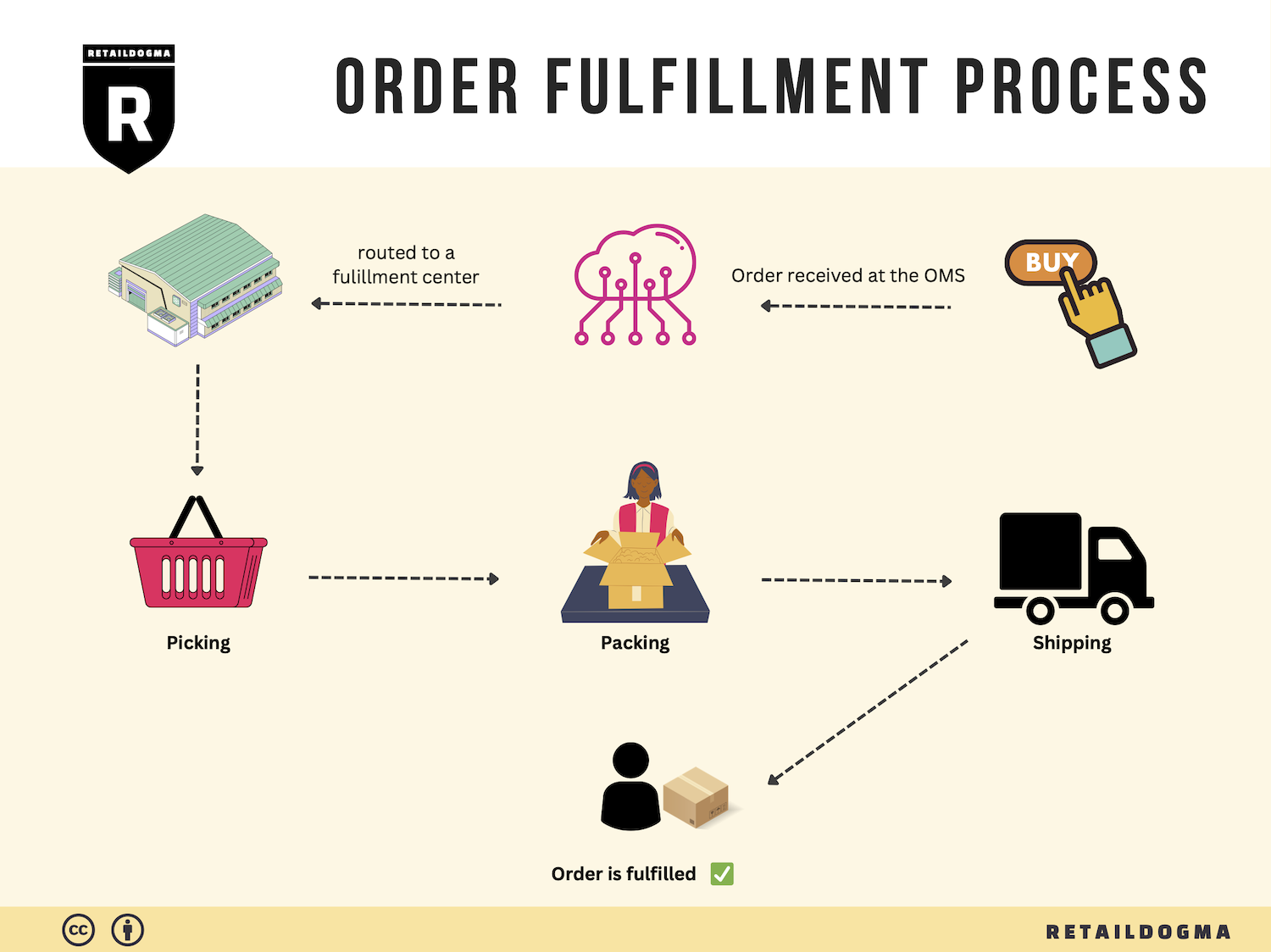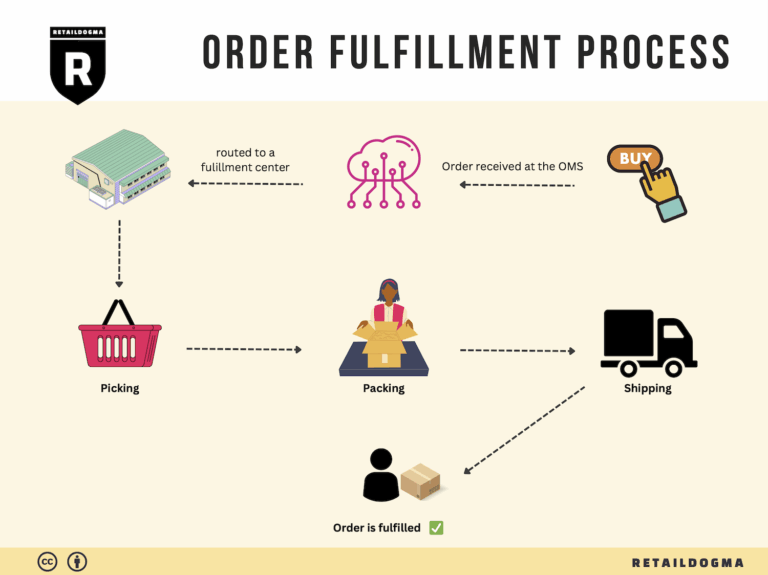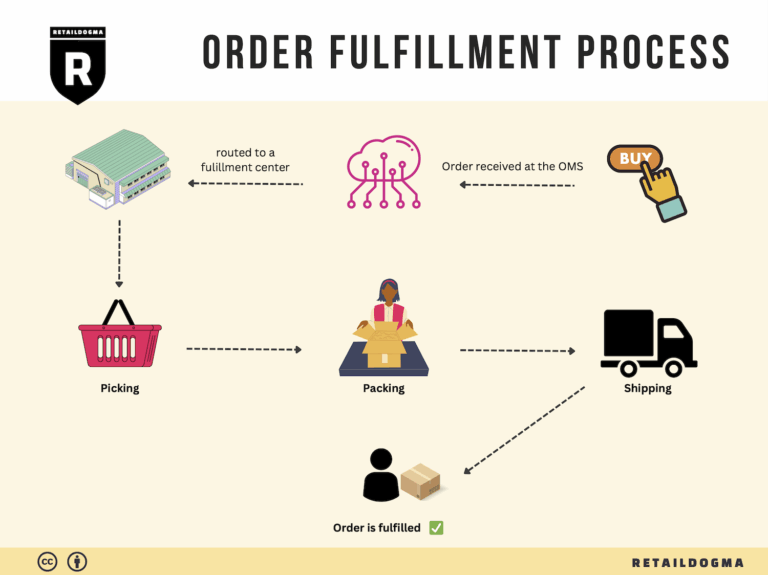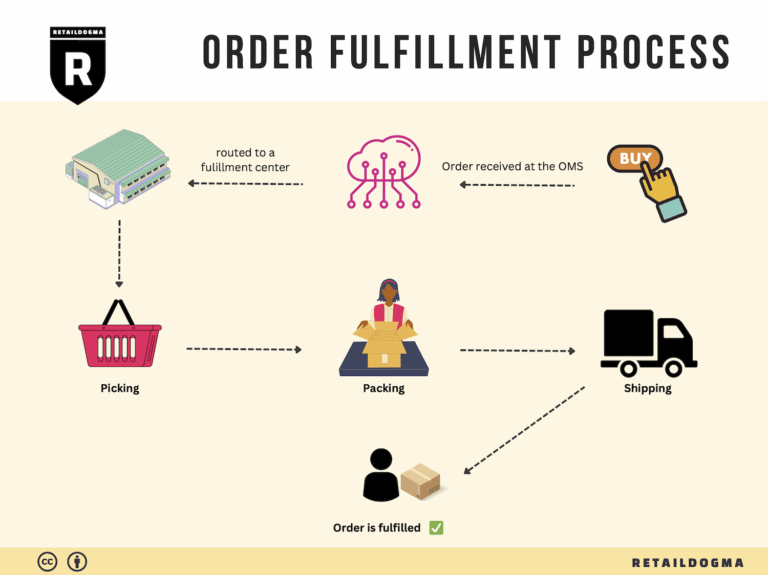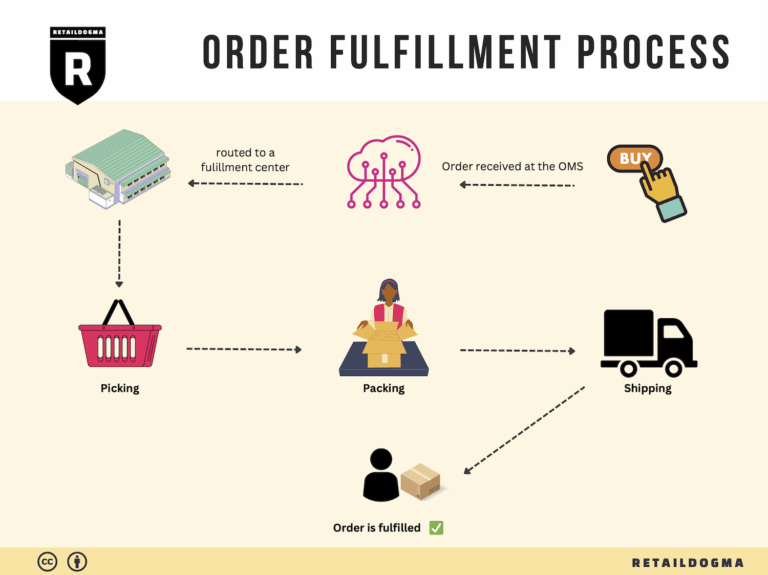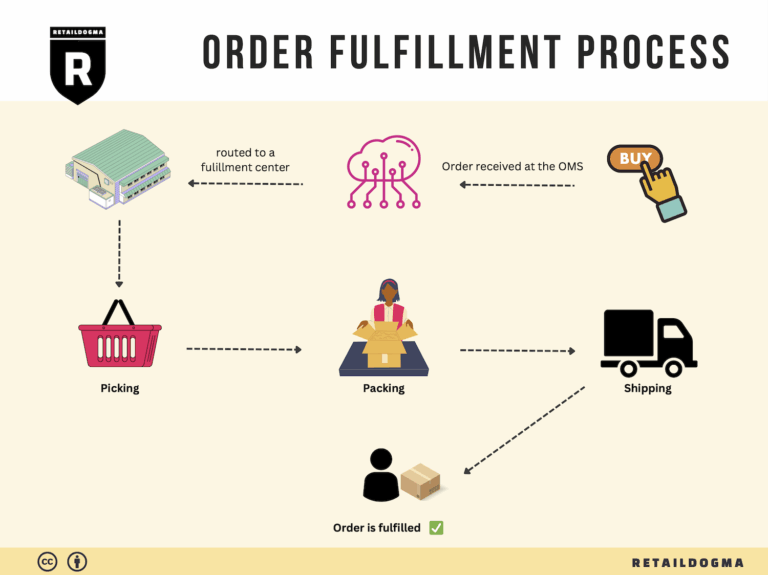How Order Fulfillment Works: A Step-by-Step Guide for Businesses
What is E-commerce Fulfillment? An Introduction for Growing Businesses
Understanding E-commerce Fulfillment: A Vital Component for Growth
As an e-commerce business owner, you may find yourself grappling with a common challenge: the overwhelming task of packing and shipping orders efficiently. The excitement of growing sales can quickly turn into stress when managing logistics, inventory, and customer satisfaction. This is where e-commerce fulfillment comes into play—a critical process that involves getting your products from your warehouse (or a third-party provider) to your customers’ doorsteps.
Fulfillment is essentially the backbone of your logistics strategy. It encompasses everything from receiving inventory and storing it, to picking, packing, and shipping orders. A streamlined fulfillment process not only enhances customer satisfaction but also supports your business’s growth and scalability.
In this guide, we will explore various fulfillment models, including Third-Party Logistics (3PL) and Fulfillment by Amazon (FBA). Understanding these models is crucial for making informed decisions that align with your business goals. Each option comes with its own set of advantages and challenges, and selecting the right one can significantly impact your operational efficiency.
We will delve into the core services offered by fulfillment providers, such as inventory management, order processing, and shipping solutions. Each of these services plays a pivotal role in ensuring that your customers receive their orders on time and in perfect condition.
Choosing the right fulfillment partner is another critical aspect we will cover. Factors such as technology integration, geographic reach, and customer service capabilities should be evaluated to ensure that your chosen partner can meet your specific needs.
Lastly, pricing is a key consideration in the fulfillment process. We will break down the various pricing structures you might encounter, helping you to understand costs associated with storage, handling, and shipping. This insight will empower you to budget effectively and optimize your profit margins.
The ultimate goal of this guide is to empower you with the knowledge and tools necessary to make smart, informed decisions about your logistics strategy. By mastering the intricacies of e-commerce fulfillment, you can streamline your operations, enhance customer satisfaction, and focus on what you do best—growing your business.

What You’ll Learn In This Guide
- What is E-commerce Fulfillment? An Introduction for Growing Businesses
- The Order Fulfillment Process: From ‘Buy’ Button to Customer’s Door
- Comparing Fulfillment Models: In-House vs. 3PL vs. Dropshipping
- A Deep Dive into Amazon FBA: Pros, Cons, and Who It’s For
- Core Services Offered by Fulfillment Centers
- How to Choose a Fulfillment Partner: A 6-Point Checklist
- Understanding Fulfillment Pricing: A Breakdown of Common Fees
- Frequently Asked Questions (FAQs) about Fulfillment
- Conclusion: Is Outsourcing Fulfillment the Right Move for Your Business?
- Important Disclaimer
The Order Fulfillment Process: From ‘Buy’ Button to Customer’s Door
1. Receiving Inventory
The first step in the order fulfillment process is receiving inventory. This stage involves accepting products from suppliers or manufacturers and ensuring they are in good condition and match the purchase orders. A crucial aspect of this step is the use of Stock Keeping Units (SKUs), which are unique identifiers for each product.
Importance: Proper receiving practices are essential for maintaining inventory accuracy and preventing stock discrepancies. It allows businesses to track inventory levels effectively, ensuring they have the right amount of stock on hand to meet customer demand. Any errors at this stage can lead to issues later in the process, such as stockouts or overstock situations.
Key Takeaway: Implement a systematic receiving process that includes thorough checks against purchase orders and the use of SKUs to streamline inventory management.
2. Warehouse Storage
Once inventory has been received, it is moved to storage locations within the warehouse. This step involves organizing products in a way that maximizes space and improves accessibility. Companies often use various storage systems, such as pallet racking or shelving, and employ a warehouse management system (WMS) to keep track of where each SKU is located.
Importance: Efficient warehouse storage is critical for reducing the time it takes to pick and pack orders. A well-organized warehouse minimizes search times, enhances inventory visibility, and enables quicker order fulfillment. It also plays a role in optimizing space, which can reduce overhead costs.
Key Takeaway: Utilize a WMS to improve inventory tracking and organization, ensuring that products are stored logically and are easily retrievable.
3. Order Picking
Order picking is the process of selecting items from inventory to fulfill a customer order. This step often involves generating pick lists, which detail the SKUs and quantities needed for each order. There are various picking methods, such as single order picking, batch picking, or zone picking, depending on the volume and complexity of orders.

Importance: The efficiency of the picking process directly affects order turnaround times and customer satisfaction. Accurate picking is vital; errors can lead to incorrect shipments, which can damage customer trust and lead to returns.
Key Takeaway: Choose the appropriate picking method based on your business’s order volume and complexity, and invest in training staff to minimize errors during the picking process.
4. Order Packing
After picking, the next step is packing the selected items. During this phase, products are securely packaged to prevent damage during transit. Proper packing materials, such as bubble wrap, packing peanuts, and sturdy boxes, are crucial. Additionally, packing slips and labels are generated to accompany the shipment.
Importance: Effective packing is essential for ensuring that products arrive at the customer’s door in pristine condition. It also helps streamline the shipping process by providing all necessary information for delivery. Poor packing can lead to damaged goods and increased return rates, ultimately affecting profitability.
Key Takeaway: Invest in quality packing supplies and develop standardized packing procedures to enhance protection and efficiency during this critical step.
5. Shipping & Delivery
The final step in the order fulfillment process is shipping and delivery. Once an order is packed, it is handed over to a carrier for transport. Businesses must choose between various shipping options based on cost, speed, and reliability. Tracking systems are often implemented to keep customers informed about their order’s status.
Importance: This step is the culmination of the entire fulfillment process and significantly impacts customer satisfaction. Timely and accurate delivery fosters trust and encourages repeat business. Moreover, understanding shipping costs and options can help optimize logistics expenses and improve profit margins.
Key Takeaway: Establish strong relationships with reliable carriers and utilize tracking systems to enhance the shipping experience, ensuring that customers receive their orders promptly and accurately.
By effectively managing each of these five steps, e-commerce businesses can optimize their order fulfillment process, leading to improved efficiency, reduced costs, and enhanced customer satisfaction. As the landscape of e-commerce evolves, staying informed about best practices in fulfillment can provide a competitive edge.
Comparing Fulfillment Models: In-House vs. 3PL vs. Dropshipping
Fulfillment Model Comparison
| Model | Who Handles Inventory | Best For (Business Stage) | Key Advantage | Key Disadvantage |
|---|---|---|---|---|
| In-House Fulfillment | The business itself | Established businesses | Full control over inventory and processes | High overhead and operational complexity |
| Third-Party Logistics (3PL) | A third-party provider | Growing businesses | Scalability and expertise | Less control over operations |
| Dropshipping | Supplier or manufacturer | Startups and small businesses | Low startup costs and risk | Lower profit margins and dependence on suppliers |
In-House Fulfillment
In-house fulfillment is a model where the e-commerce business manages all aspects of inventory storage, order processing, and shipping. This approach is often utilized by established businesses that have the resources to handle logistics internally. One of the primary advantages of in-house fulfillment is the level of control it provides. Businesses can dictate every aspect of their operations, from inventory management to quality control, ensuring that their customers receive consistent service. Additionally, having a dedicated fulfillment team can facilitate faster response times to customer inquiries and allow for personalized service. However, this model comes with significant disadvantages. The overhead costs associated with warehousing, staffing, and technology can be substantial, making it challenging for smaller companies or those just starting out. Operational complexity also increases, as businesses must manage logistics alongside their core functions, which can detract from growth and innovation efforts.
Third-Party Logistics (3PL)
Third-party logistics (3PL) providers offer a versatile solution for businesses looking to outsource their fulfillment processes. In this model, a specialized logistics company handles inventory storage, order processing, and shipping on behalf of the e-commerce business. This approach is particularly beneficial for growing companies that need to scale their operations quickly without incurring the high costs of in-house logistics. One of the key advantages of using a 3PL is access to industry expertise and advanced technology, allowing businesses to optimize their supply chain and logistics processes. Furthermore, 3PLs often have established relationships with carriers, which can lead to better shipping rates and improved delivery times. However, the trade-off is that businesses may experience a reduction in control over their operations. When outsourcing fulfillment, companies must rely on their 3PL partner to maintain service levels and quality standards, which can pose risks if the provider does not meet expectations.
Dropshipping
Dropshipping is a fulfillment model that allows e-commerce businesses to sell products without holding any inventory. Instead, when a customer places an order, the business purchases the item from a supplier or manufacturer, who then ships the product directly to the customer. This model is particularly appealing for startups and small businesses, as it requires minimal upfront investment and significantly reduces financial risk. One of the most attractive features of dropshipping is the low barrier to entry; entrepreneurs can launch an online store without the need to invest in inventory or warehouse space. However, dropshipping does have its disadvantages. Profit margins can be lower compared to other fulfillment models, as businesses often pay a premium for the convenience of not handling inventory themselves. Additionally, dropshipping can lead to issues with supplier reliability, as businesses have little control over stock levels and shipping times, which can affect customer satisfaction and brand reputation.
In summary, choosing the right fulfillment model depends on the specific needs and stage of your business. In-house fulfillment offers control but comes with high costs, 3PL provides scalability and expertise but may reduce operational control, and dropshipping lowers financial risk but can compromise margins and reliability. Each model has its unique advantages and challenges, and e-commerce businesses must carefully evaluate their goals and resources to select the best option for their logistics strategy.
A Deep Dive into Amazon FBA: Pros, Cons, and Who It’s For
Understanding Fulfillment by Amazon (FBA)
Fulfillment by Amazon (FBA) is a service provided by Amazon that allows businesses to store their products in Amazon’s fulfillment centers. Amazon then takes care of storage, packaging, shipping, and customer service on behalf of the sellers. This service is particularly advantageous for e-commerce businesses looking to scale their operations without the overhead of managing logistics and warehousing.
How FBA Works
-
Product Listing: Sellers create product listings on Amazon and specify that they want to use FBA.
-
Shipping to Amazon: Sellers send their products to Amazon’s fulfillment centers. They can choose to ship products in bulk or as individual units.
-
Storage: Once the products arrive at the fulfillment center, Amazon stores them until they are sold.
-
Order Processing: When a customer places an order, Amazon handles the picking, packing, and shipping of the product.
-
Customer Service: Amazon provides customer service for the products sold through FBA, handling inquiries, returns, and refunds.
-
Payment: After the product is sold, the seller receives payment, minus any applicable fees.
Pros of Using FBA
1. Prime Eligibility
One of the standout advantages of using FBA is the eligibility for Amazon Prime. Products fulfilled by Amazon can be listed with the Prime badge, which significantly increases visibility and attractiveness to customers who prioritize fast, free shipping. This can lead to higher conversion rates and sales.
2. Customer Trust
Amazon is a trusted platform with a strong reputation for customer service. By utilizing FBA, sellers benefit from this trust, as customers are more likely to purchase from sellers who offer Amazon’s fulfillment services, knowing they will receive reliable service and support.
3. Multi-Channel Fulfillment
FBA is not limited to Amazon’s marketplace. Sellers can use FBA to fulfill orders from their own websites or other sales channels. This multi-channel fulfillment capability allows businesses to streamline their logistics and inventory management across various platforms.
4. Scalability
FBA allows sellers to scale their operations without the need for significant investment in logistics infrastructure. As demand grows, sellers can send more inventory to Amazon’s fulfillment centers, and Amazon will handle the increased order volume seamlessly.
5. Time Savings
By outsourcing fulfillment to Amazon, sellers can focus more on other aspects of their business, such as marketing and product development, rather than spending time on packing and shipping orders.
Cons of Using FBA
1. High Fees
While FBA offers many benefits, it comes with costs that can eat into profit margins. Amazon charges fees for storage, order fulfillment, and additional services. These fees can add up, especially for sellers with lower-priced products or those that do not sell quickly.
2. Strict Inventory Rules
FBA has strict inventory management policies. Sellers must adhere to guidelines regarding how many units can be stored and how long they can remain in the fulfillment center. Exceeding storage limits or having excess inventory can lead to additional fees or inventory removal.
3. Commingling Risks
FBA utilizes a commingling system, where products from different sellers are stored together. This can pose risks for sellers regarding product quality and returns. If a customer receives a defective or incorrect item, it can negatively impact the seller’s reputation, even if the issue originated with another seller’s inventory.
4. Limited Control
When using FBA, sellers relinquish some control over the fulfillment process. This includes packaging and shipping methods, which may not align with a seller’s brand image or customer expectations.
5. Complexity in Returns
While Amazon handles returns for FBA sellers, the process can sometimes be complex. Sellers may have limited insights into the reasons for returns, which can hinder their ability to improve product offerings or customer satisfaction.
Who is FBA Best For?
FBA is particularly beneficial for small to medium-sized e-commerce businesses looking to streamline operations and enhance their market presence. Here are some specific scenarios where FBA might be the right choice:
-
Startups: New businesses that lack the infrastructure to manage logistics can benefit from the scalability and efficiency of FBA.
-
High-Volume Sellers: Businesses with a high volume of sales can take advantage of Amazon’s vast distribution network to meet customer demand efficiently.
-
Product-Based Businesses: Companies selling physical products, especially those with a variety of SKUs, can simplify inventory management and fulfillment processes.
-
Seasonal Sellers: Businesses that experience seasonal spikes in demand can use FBA to handle increased order volumes without the need to hire temporary staff or manage additional warehousing.
-
Multi-Channel Sellers: E-commerce businesses selling on multiple platforms can utilize FBA to manage fulfillment across all channels, allowing for a more streamlined operation.
In conclusion, while FBA offers significant advantages for e-commerce businesses, it is essential for sellers to weigh these benefits against the associated costs and challenges. Understanding how FBA fits into a business’s overall strategy is crucial for maximizing its potential as a fulfillment solution.
Core Services Offered by Fulfillment Centers
Inventory Management & Warehousing
Fulfillment centers provide comprehensive inventory management and warehousing solutions designed to streamline the storage and tracking of products. This service encompasses the storage of goods in a facility equipped with advanced inventory tracking systems, which allows businesses to monitor stock levels in real-time.
Benefits:
1. Optimized Space Utilization: Fulfillment centers utilize sophisticated storage systems to maximize warehouse space, ensuring that e-commerce businesses can store more products without the overhead of managing their own facility.
2. Real-Time Inventory Tracking: With advanced technology in place, fulfillment centers provide businesses with the ability to track inventory levels, orders, and shipments in real-time. This transparency helps prevent stockouts and overstock situations, enabling better demand forecasting.
3. Scalability: As a business grows, its inventory needs change. Fulfillment centers can easily adjust storage capacities, allowing businesses to scale operations without the complexities of moving to a larger warehouse or managing logistics in-house.
Pick and Pack Services
Pick and pack services are crucial for fulfilling customer orders efficiently. This process involves selecting items from the warehouse (picking) and packaging them for shipment (packing). Fulfillment centers employ specialized staff and technology to ensure accuracy and speed in this process.
Benefits:
1. Efficiency: Fulfillment centers are designed for high-volume operations, allowing for quick order processing. This efficiency can significantly reduce shipping times, which is critical for maintaining customer satisfaction in today’s fast-paced e-commerce environment.
2. Accuracy: Automated systems and trained personnel minimize errors in order fulfillment. Accurate picking and packing reduce the costs associated with returns and reshipments, ultimately saving time and money for the business.
3. Customization: Many fulfillment centers offer customizable packing options, including branded packaging or specific packing materials, which can enhance the customer experience and reinforce brand identity.
Kitting and Assembly
Kitting and assembly services involve the grouping of multiple items into a single package or kit, which is then shipped to customers. This service is particularly beneficial for businesses that offer bundled products or require assembly of components before shipping.
Benefits:
1. Enhanced Product Offering: By utilizing kitting services, businesses can offer product bundles that may increase average order value. For instance, a beauty brand might bundle skincare products together, providing customers with a complete solution.
2. Time-Saving: Outsourcing kitting and assembly to a fulfillment center frees up internal resources, allowing businesses to focus on core activities such as product development and marketing rather than logistics.
3. Quality Control: Fulfillment centers often have quality control measures in place during the kitting process, ensuring that all components of a kit meet the required standards before shipment. This helps maintain customer satisfaction and brand reputation.
Returns Management (Reverse Logistics)
Returns management, or reverse logistics, refers to the process of handling returned products. Fulfillment centers typically offer services that streamline the returns process, making it easier for both the business and the customer.
Benefits:
1. Streamlined Processes: Fulfillment centers have established systems for handling returns, which can help reduce processing time and improve customer satisfaction. Quick turnaround on returns can encourage repeat business, as customers appreciate hassle-free return policies.
2. Inventory Reclamation: Efficient returns management allows businesses to quickly assess the condition of returned items and reintegrate them into inventory if possible. This minimizes loss and maximizes the potential for resale.
3. Data Insights: Returns management processes often include analytics that provide insights into return trends. Understanding why products are returned can help businesses improve product quality, customer satisfaction, and ultimately, reduce return rates.
Conclusion
In today’s competitive e-commerce landscape, leveraging the core services offered by fulfillment centers is essential for businesses looking to scale efficiently. By outsourcing inventory management, pick and pack services, kitting and assembly, and returns management, e-commerce businesses can focus on growth and innovation, while ensuring a seamless experience for their customers.
How to Choose a Fulfillment Partner: A 6-Point Checklist
Location & Warehouse Network
Importance: The geographical location of your fulfillment partner’s warehouses can significantly impact shipping times and costs. A partner with a well-distributed network can offer faster delivery to your customers, which is crucial in today’s competitive e-commerce landscape.
Questions to Ask:
– Where are your warehouses located, and how do they align with my customer base?
– Do you have the ability to open additional locations if my business expands?
– How do you handle shipping logistics for international orders?
Technology & Integrations
Importance: A fulfillment partner should utilize advanced technology to manage inventory, track shipments, and integrate seamlessly with your existing e-commerce platforms. This can enhance efficiency, reduce errors, and provide real-time visibility into your supply chain.
Questions to Ask:
– What inventory management systems do you use, and how do they integrate with my e-commerce platform (e.g., Shopify, WooCommerce, Amazon)?
– Can you provide real-time tracking for shipments, and how do you communicate this information to customers?
– Are there any additional software tools or APIs available to enhance our partnership?
Specializations (e.g., cold storage, oversized items)
Importance: Depending on your product type, you may need a partner that specializes in specific storage conditions or types of items. For example, if you sell perishables, cold storage capabilities are essential. If you deal with oversized items, ensure the partner can handle the logistics effectively.
Questions to Ask:
– Do you have specialized facilities for my product type (e.g., temperature-controlled storage, oversized item handling)?
– What processes do you have in place to ensure product safety and integrity during storage and shipping?
– Can you provide case studies or references for similar products you have successfully managed?
Scalability & Capacity
Importance: As your business grows, your fulfillment partner must be able to scale operations to meet increased demand. A partner with ample capacity can prevent disruptions during peak seasons or rapid growth phases.
Questions to Ask:
– How do you manage capacity during peak seasons (e.g., holidays, sales)?
– What is your process for scaling operations, and can you accommodate sudden spikes in order volume?
– Can you provide data on your current capacity and any historical data on how you’ve handled growth?
Pricing and Contracts
Importance: Understanding the pricing structure and contract terms is vital for budgeting and financial planning. Transparency in costs will help avoid unexpected fees that can erode your profit margins.
Questions to Ask:
– What are your pricing models (e.g., per order, per item, monthly fees), and what factors can influence these costs?
– Are there additional fees for services like storage, packing, or returns management?
– Can you provide a sample contract, including any clauses related to termination or service level agreements?
Customer Support & Reviews
Importance: Excellent customer support can be a game-changer in logistics. A responsive partner can quickly resolve issues, ensuring a smooth experience for both you and your customers. Additionally, customer reviews can provide insights into the reliability and performance of a potential partner.
Questions to Ask:
– What customer support channels do you offer (e.g., phone, email, chat), and what are your typical response times?
– Can you provide references or case studies from current or past clients?
– How do you handle disputes or issues, and what is your escalation process?
Conclusion
Choosing the right fulfillment partner is a critical decision that can significantly impact your e-commerce business’s success. By using this checklist, you can systematically evaluate potential partners based on essential criteria, ensuring that they align with your operational needs and growth objectives. Prioritize open communication and transparency throughout the selection process to foster a productive partnership that supports your business’s scaling efforts.
Understanding Fulfillment Pricing: A Breakdown of Common Fees
Initial Setup Fees
When partnering with a fulfillment service, the initial setup fee is often the first cost you’ll encounter. This fee typically covers the onboarding process, which may include account setup, integration with your e-commerce platform, and initial training sessions. The setup fee can vary significantly based on the complexity of your operations and the fulfillment center’s capabilities. For instance, if you require custom software integrations or specific reporting features, expect to pay more.
To calculate this fee, fulfillment centers usually assess the following factors:
– The number of SKUs (Stock Keeping Units) to be managed
– The complexity of the integration with your current systems
– Any additional training or support needed during the onboarding phase
It’s crucial to clarify what is included in the initial setup fee to avoid hidden costs later on.
Receiving Fees
Receiving fees are charged when your inventory arrives at the fulfillment center. This fee compensates the facility for unloading, inspecting, and storing your products. It is typically calculated per pallet or per unit and can vary based on the type of products being received. For example, bulk items may incur lower per-unit fees than fragile or complex items that require special handling.
Factors influencing receiving fees include:
– The volume of items received
– The condition and organization of the shipment
– The need for additional inspections or quality checks
To minimize receiving fees, ensure that your shipments are organized and well-documented, which can expedite the receiving process.
Storage Fees (per pallet/bin)
Storage fees are charged for keeping your inventory in the fulfillment center. These fees can be calculated on a monthly basis and may vary depending on whether you are using pallet space or bin space. Generally, storage fees are assessed based on the volume of space your products occupy and can be charged per pallet or per bin.
Common aspects that affect storage fees include:
– The size and weight of your products
– The length of time your inventory is stored
– Seasonal demand fluctuations (e.g., higher fees during peak seasons)
To effectively manage storage costs, consider implementing a just-in-time inventory strategy or regularly auditing your stock levels to ensure you are not paying for excess inventory.
Pick & Pack Fees (per item/order)
Pick and pack fees are incurred each time an order is processed. This fee covers the costs associated with picking items from the warehouse, packing them for shipment, and preparing them for delivery. Pick and pack fees can be calculated either per item or per order, depending on the fulfillment service provider’s pricing structure.
Key factors influencing pick and pack fees include:
– The number of items in each order (more items typically lead to higher fees)
– The complexity of packing (e.g., special packaging requirements)
– The frequency of returns, which may require additional handling
To reduce pick and pack fees, consider optimizing your product assortments and packaging strategies. Streamlined processes can lead to more efficient order fulfillment.
Shipping Fees
Shipping fees are one of the most variable costs associated with fulfillment services. These fees depend on several factors, including the shipping carrier, the destination, the weight and dimensions of the package, and the shipping speed selected. Fulfillment centers often negotiate shipping rates with carriers, and these savings can be passed on to you.
Shipping fee considerations include:
– The choice between standard, expedited, or same-day shipping
– The geographical distance between the fulfillment center and the customer
– Any special delivery requirements (e.g., signature confirmation)
To ensure you receive the best shipping rates, regularly review your shipping options and consider consolidating shipments whenever possible.
Tips for Getting an Accurate Quote
-
Provide Detailed Information: When seeking quotes from fulfillment centers, provide as much detail as possible about your inventory, order volume, and specific needs. This includes SKU counts, product dimensions, and seasonal fluctuations.
-
Ask About Hidden Fees: Inquire about any potential hidden fees that may arise during the fulfillment process, such as return handling fees or extra charges for special packaging.
-
Request a Breakdown: A reputable fulfillment partner should be able to provide a detailed breakdown of their pricing structure, including all applicable fees.
-
Negotiate Terms: Don’t hesitate to negotiate terms and rates. Many fulfillment providers are open to adjusting fees, especially if you can demonstrate a long-term partnership potential.
-
Compare Multiple Providers: Finally, compare quotes from several fulfillment centers to ensure you’re getting competitive rates and services that align with your business needs.
By understanding these common fulfillment pricing models and following these tips, you can make informed decisions that support your business’s growth and scalability.
Frequently Asked Questions (FAQs) about Fulfillment
1. What caused the recent layoffs of Amazon FBA support staff?
Amazon recently laid off approximately 200 employees within its Fulfillment by Amazon (FBA) support organization as part of a routine review of its team structures. This decision was made to enhance operational efficiency and ensure that the company can continue to serve its customers effectively. The layoffs are not expected to affect the level of support provided to Amazon sellers.
2. How will these layoffs impact Amazon sellers?
According to Amazon, the layoffs will not impact the services or support provided to sellers using the FBA program. The company has committed to maintaining the same level of support, ensuring that sellers can continue to access resources and assistance as needed.
3. What is the difference between a warehouse and a fulfillment center?
A warehouse is primarily used for storage, where goods are kept until they are needed. In contrast, a fulfillment center is designed for the rapid processing and shipping of orders. Fulfillment centers manage inventory, pick and pack items, and handle shipping logistics, making them integral to e-commerce operations.
4. What is a Third-Party Logistics Provider (3PL)?
A Third-Party Logistics Provider (3PL) is a company that offers logistics services to businesses, including warehousing, fulfillment, and distribution. Utilizing a 3PL allows e-commerce businesses to outsource their logistics operations, enabling them to focus on core business activities such as sales and marketing.
5. How much do fulfillment services cost?
The cost of fulfillment services can vary widely depending on several factors, including the size and weight of products, order volume, storage requirements, and specific services needed (e.g., packaging, shipping, returns management). Typically, fulfillment costs include storage fees, picking and packing fees, and shipping costs. It is advisable to compare different providers to find a solution that fits your business model.
6. What technologies is Amazon using to support FBA sellers post-layoffs?
Amazon has introduced technologies like Project Amelia, a chatbot designed to assist FBA sellers by answering questions related to inventory and sales metrics. This automated support aims to streamline seller inquiries and reduce the need for human intervention, although Amazon assures that human support options will remain available.
7. Are there other recent changes in Amazon’s operations besides these layoffs?
Yes, Amazon has been actively restructuring various parts of its operations, including the closure of unprofitable initiatives and the reduction of roles across different divisions. These changes are part of a broader strategy led by Amazon’s CEO to control costs and enhance efficiency.
8. What support is available for employees affected by the layoffs?
Amazon has stated that it is committed to supporting employees whose roles have been eliminated. This support may include severance packages, career transition services, and assistance in finding new employment opportunities within or outside the company.
9. How can e-commerce businesses adapt to the changes in Amazon’s fulfillment support?
E-commerce businesses should consider diversifying their logistics strategies by exploring alternative fulfillment providers or enhancing their in-house logistics capabilities. Staying informed about changes in Amazon’s policies and support structures is also essential to ensure continued operational efficiency.
10. What should sellers do if they experience issues with FBA after these layoffs?
Sellers should utilize the available support channels, including the Project Amelia chatbot for immediate inquiries. If further assistance is required, sellers can reach out through Amazon’s customer service options, which remain unchanged despite the layoffs. Keeping clear documentation of any issues will help facilitate quicker resolutions.
Conclusion: Is Outsourcing Fulfillment the Right Move for Your Business?
Evaluating the Benefits of Outsourcing Fulfillment
Outsourcing your fulfillment process can be a transformative decision for your e-commerce business, particularly in an environment marked by increasing competition and shifting consumer expectations. By leveraging a third-party fulfillment service, you can save valuable time that can be redirected toward strategic growth initiatives. Instead of getting bogged down in the logistics of inventory management, shipping, and customer service, you can focus on enhancing your product offerings and marketing strategies.
Scalability is another compelling advantage of using a fulfillment service. As your business grows, so do your fulfillment needs. A capable partner can seamlessly adjust to fluctuating order volumes, ensuring that you can meet demand without the headaches of managing additional warehouse space or hiring temporary staff. This flexibility allows you to scale operations efficiently, whether you’re experiencing seasonal spikes or launching new product lines.
Furthermore, fulfillment service providers often bring a wealth of expertise to the table. They have established systems, advanced technology, and industry knowledge that can improve your logistics processes. This expertise not only enhances efficiency but can also lead to cost savings in shipping and inventory management—benefits that can significantly impact your bottom line.
However, the success of outsourcing fulfillment hinges on choosing the right partner. It’s crucial to conduct thorough research and due diligence, ensuring that the provider aligns with your business goals and values. Consider factors such as their technology capabilities, customer service reputation, and experience within your industry.
Take Action
As you contemplate whether outsourcing fulfillment is the right move for your business, take a moment to audit your current shipping processes. Assess your operational efficiency, costs, and scalability. This evaluation will help you determine if a fulfillment partner could be the next strategic step in your growth journey. Don’t overlook the potential benefits of outsourcing—make the informed choice that best positions your business for success.
Important Disclaimer
⚠️ Important Disclaimer
The information in this guide is for educational purposes. Fulfillment services, pricing, and platform features change frequently. Always conduct your own due diligence and consult with providers directly before making business decisions.
